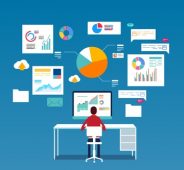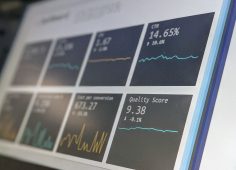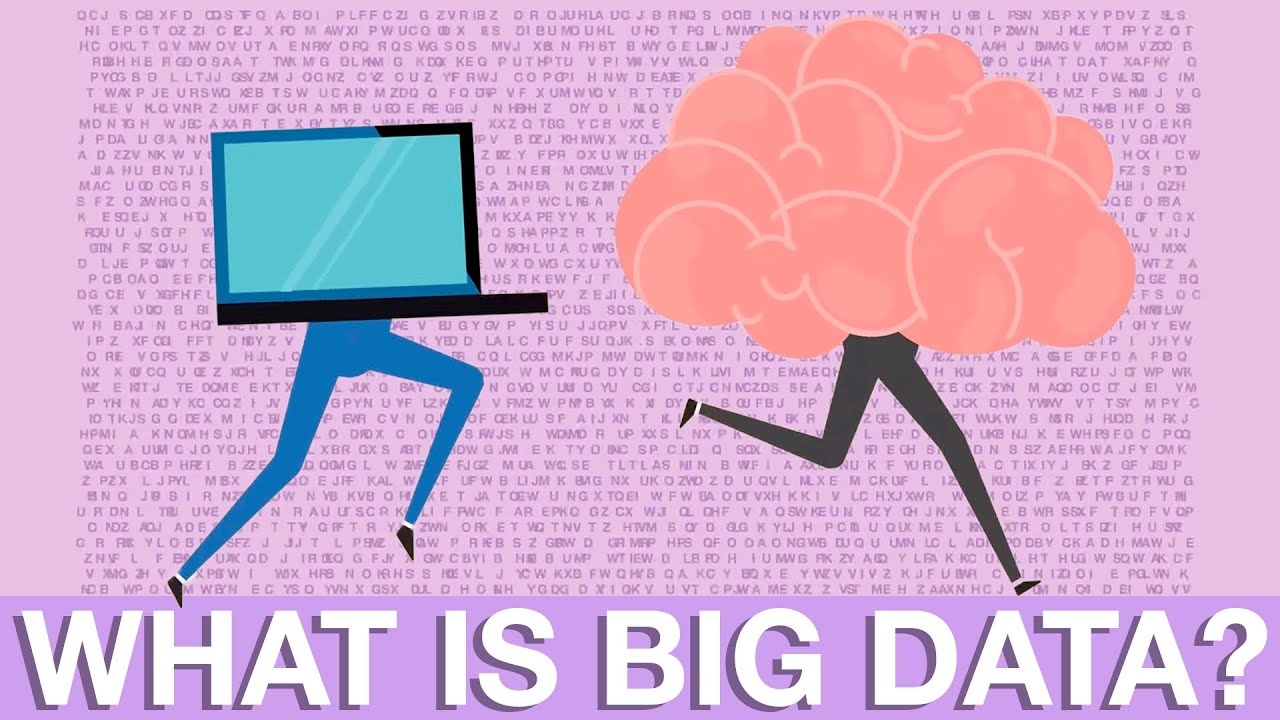Introduction
Big data has become an invaluable asset in today’s digital age. It refers to large sets of data that are too complex and voluminous for traditional data processing techniques to handle effectively. Big data holds immense potential for organizations and researchers looking to gain valuable insights and make data-driven decisions.
With the abundance of data available, the challenge lies in finding reliable sources of big data. Fortunately, there are numerous platforms, institutions, and organizations that provide access to large datasets for various purposes. Whether you’re a data scientist, a researcher, or simply someone interested in exploring the vast world of data, knowing where to find big data is crucial.
In this article, we will explore some prominent sources where you can access big data. These sources offer a diverse range of datasets, including public datasets, government open data, social media platforms, e-commerce websites, research institutions and universities, health and medical data sources, financial and economic data sources, weather and climate data sources, and transportation and mobility data sources.
By harnessing the power of big data, you can uncover valuable insights, detect patterns, predict trends, and make informed decisions. Let’s dive into the various sources where you can obtain big data.
Public Datasets
Public datasets are one of the most accessible and abundant sources of big data. These datasets are created and made available by government agencies, research institutions, non-profit organizations, and other entities for public use. Public datasets cover a wide range of topics, including demographics, education, healthcare, transportation, and more.
One of the largest and most well-known platforms for accessing public datasets is the data.gov website, which is managed by the U.S. government. This platform provides access to a vast collection of datasets from various federal agencies, such as the Department of Commerce, Department of Health and Human Services, and the Environmental Protection Agency. These datasets can be downloaded in various formats, such as CSV, JSON, and XML, making them compatible with different data analysis tools and programming languages.
Another notable platform for public datasets is Kaggle. Kaggle is a community-driven platform that hosts datasets, competitions, and data science projects. It offers a wide range of publicly available datasets contributed by users worldwide. Users can access and download these datasets for their own analysis or participate in Kaggle’s data science challenges.
In addition to these platforms, various government agencies and research institutions also maintain their own repositories of public datasets. For example, the National Oceanic and Atmospheric Administration (NOAA) provides access to weather and climate data through its National Centers for Environmental Information (NCEI) website. Similarly, the World Bank offers an extensive collection of socio-economic datasets through its World Bank Open Data platform.
Public datasets are often rich in diverse and comprehensive data, making them valuable resources for researchers, data scientists, and anyone interested in exploring the world of big data. These datasets can be used for various purposes, such as academic research, business analytics, policy-making, and developing data-driven solutions. By leveraging public datasets, you can gain valuable insights and contribute to the advancement of knowledge in your field.
Government Open Data
Government open data refers to datasets that are provided by governmental entities and made available to the public. Governments around the world today recognize the importance of transparency and sharing information with their citizens. As a result, they have launched open data initiatives, creating platforms where various datasets can be accessed by the public.
One of the most notable government open data platforms is data.gov. Managed by the U.S. government, data.gov hosts a wide variety of datasets contributed by federal agencies. These datasets cover diverse topics, such as demographics, healthcare, education, transportation, and more. The platform provides easy access to datasets in various formats, making them accessible to researchers, developers, and the general public.
Similarly, the European Union has its own open data portal called European Data Portal. This platform serves as a gateway to a vast collection of open datasets from EU member states. It covers a wide range of subjects, including economics, environment, society, and more. The European Data Portal offers advanced search capabilities and tools that enable users to find and download datasets of interest.
In addition to these large-scale initiatives, many individual government agencies also release open datasets. For example, the United States Census Bureau publishes demographic data, economic indicators, and geographical information through its Census Data platform. These datasets are valuable resources for researchers, businesses, and policymakers.
Government open data provides valuable insights into various aspects of society and enables data-driven decision-making. Researchers can leverage these datasets to analyze trends, identify patterns, and develop evidence-based policies. Similarly, businesses can utilize government open data to gain insights into market trends, consumer behavior, and economic indicators. By promoting transparency and accessibility, government open data initiatives contribute to the advancement of knowledge and the improvement of public services.
Social Media Platforms
Social media platforms have become a treasure trove of valuable data for researchers, marketers, and businesses. With billions of users worldwide, these platforms generate massive amounts of data every day, offering insights into consumer behavior, sentiment analysis, and social trends.
Social media platforms such as Facebook, Twitter, Instagram, and LinkedIn provide access to various APIs (Application Programming Interfaces) that allow developers and researchers to collect and analyze publicly available data. These APIs enable users to access user profiles, posts, comments, likes, and other engagement metrics.
Facebook, with its extensive user base and rich user-generated content, offers the Facebook Graph API. This API provides access to public posts, comments, user information, and more. Researchers can use this data to study social interactions, sentiment analysis, and user behavior patterns.
Twitter, known for its real-time nature, offers the Twitter API. This API allows access to tweets, user profiles, hashtags, and other Twitter-specific information. Researchers and marketers can leverage this data to track trends, analyze sentiment, and gain insights into public opinion.
Instagram, known for its visual content, offers the Instagram API. This API allows access to public posts, user profiles, comments, and engagement metrics. Researchers and marketers can utilize this data to analyze visual trends, study user behavior, and identify influential users.
LinkedIn, a professional networking platform, offers the LinkedIn API. This API provides access to user profiles, job listings, company information, and more. Researchers can use this data for recruitment analysis, professional network research, and market insights.
These social media platforms offer valuable data to understand user behavior, sentiment, and trends. Researchers and businesses can leverage this data to gain insights into customer preferences, market trends, and conduct social network analysis. However, it is essential to adhere to the respective platform’s terms of service and privacy policies when accessing and using social media data.
E-commerce Websites
E-commerce websites have revolutionized the way we shop and have also become a rich source of valuable data. These platforms host vast amounts of product information, transactional data, customer reviews, and more. Accessing and analyzing this data can provide valuable insights into consumer behavior, market trends, and product performance.
One of the most well-known e-commerce platforms is Amazon. Amazon provides access to its product catalog and customer reviews through its Marketplace Products API. This API allows developers to retrieve product details, search for specific products, and access customer reviews. Researchers and businesses can utilize this data to analyze customer sentiments, track product popularity, and gain insights into market trends.
Another major e-commerce platform is eBay. eBay offers the eBay API, which provides access to product listings, buyer and seller information, transaction history, and more. Researchers and businesses can leverage this data to study market dynamics, track consumer preferences, and analyze pricing trends.
In addition to these large-scale platforms, many other niche e-commerce websites and marketplaces offer APIs or data feeds that provide access to their product catalogs, pricing information, and customer reviews. These platforms can specialize in specific product categories such as electronics, fashion, or home goods.
By tapping into e-commerce website data, researchers and businesses can gain insights into consumer preferences, market trends, and product performance. This data can be used to improve marketing strategies, optimize product offerings, and enhance the overall customer experience.
However, it is essential to respect user privacy and adhere to the terms and conditions of the e-commerce platforms when accessing and utilizing their data.
Research Institutions and Universities
Research institutions and universities play a crucial role in generating and sharing valuable data for academic and scientific purposes. These institutions conduct research across various disciplines and often make their datasets available to the public. Accessing these datasets can provide researchers, students, and professionals with valuable resources for further analysis and study.
One prominent example is the Internet Archive, a non-profit digital library that offers a vast collection of datasets. This platform provides access to a wide range of datasets, including text, images, audio, and video, making it a valuable resource for researchers and developers in various fields.
Many universities also maintain their own data repositories and openly publish research datasets. For instance, Stanford University hosts the Stanford Network Analysis Project, which offers a collection of social and information networks datasets. These datasets can be used to study social interactions, network dynamics, and information diffusion.
Moreover, research institutions and universities often publish their research papers and associated datasets. Websites like ResearchGate and arXiv provide platforms for researchers to share their work and datasets with the academic community.
In addition to these general platforms, many research institutions have domain-specific repositories and databases. For example, the National Center for Biotechnology Information (NCBI) provides access to a diverse range of biological and genetic datasets through its website. These datasets are valuable resources for biology, genetics, and medical research.
Accessing datasets from research institutions and universities can provide researchers and students with a wealth of information and resources for analysis and study. These datasets enable researchers to replicate experiments, validate findings, and build upon existing research, leading to new discoveries and advancements in various fields.
However, it is important to acknowledge and respect the data usage policies and regulations set by the respective institutions when accessing and utilizing their datasets.
Health and Medical Data Sources
Health and medical data play a critical role in advancing healthcare research, improving patient outcomes, and shaping healthcare policies. Fortunately, there are various sources where researchers and organizations can access health and medical datasets for their studies and analyses.
One significant source of health data is government agencies and public health organizations. The Centers for Disease Control and Prevention (CDC) in the United States, for example, provides access to a wide range of health datasets through its Data and Statistics page. These datasets cover areas such as disease surveillance, mortality rates, birth statistics, and more. Researchers and policy makers can utilize this data to understand health trends, track disease outbreaks, and plan public health interventions.
Another valuable health data source is electronic health records (EHRs) and medical claims data. These datasets capture patient medical histories, diagnoses, treatments, and outcomes. Organizations such as hospitals, clinics, and insurance providers can offer access to anonymized and de-identified EHR and claims data for research purposes. These datasets are instrumental in clinical research, population health studies, and health outcome evaluations.
Furthermore, academic medical centers and research institutions often maintain their own health data repositories. These repositories house datasets collected through clinical trials, observational studies, and research initiatives. Researchers can access these datasets to explore specific health conditions, test hypotheses, and develop innovative medical treatments.
In recent years, data-sharing initiatives and collaborations have emerged to facilitate access to health data. For example, the Observational Health Data Sciences and Informatics (OHDSI) collaboratory aims to harmonize and share global health data for large-scale observational studies. Researchers can join this collaborative network to access diverse health datasets and contribute to multinational health research.
Accessing health and medical data opens up new possibilities for research, healthcare innovation, and policy development. By analyzing these datasets, researchers can identify disease patterns, evaluate treatment effectiveness, and uncover factors influencing health outcomes. However, it is crucial to adhere to ethical and legal considerations, such as obtaining appropriate approvals and ensuring data privacy and confidentiality when working with health and medical data.
Financial and Economic Data Sources
Financial and economic data are essential for understanding market trends, making informed investment decisions, and conducting economic research. There are various sources where researchers, economists, and financial analysts can access reliable and comprehensive financial and economic datasets.
One primary source of financial data is financial market exchanges and regulatory bodies. Exchanges such as the New York Stock Exchange (NYSE) and the London Stock Exchange (LSE) offer APIs that provide access to real-time and historical stock market data. These datasets include stock prices, trading volumes, company financials, and other market indicators, enabling researchers and market participants to analyze market trends and monitor the performance of specific stocks and indices.
Government agencies also play a crucial role in providing economic data. For example, the U.S. Census Bureau offers access to various economic datasets, including demographic statistics, retail sales, trade data, and more, through their data portal. Similarly, the U.S. Bureau of Economic Analysis provides comprehensive economic data, including GDP, employment figures, inflation rates, and more, through their website. These datasets are invaluable for economic research, forecasting, and policy development.
Financial data providers and organizations, such as Bloomberg, FactSet, and Thomson Reuters, compile and distribute vast amounts of financial and economic data to their subscribers. These platforms offer datasets on company financials, economic indicators, market news, and more. They also provide analytical tools and robust search capabilities, allowing users to conduct in-depth financial analysis and market research.
In addition to these sources, central banks and international organizations also release economic and financial data. The International Monetary Fund (IMF), World Bank, and European Central Bank (ECB) offer access to datasets on global economic indicators, financial market volatility, lending rates, and other macroeconomic data. Furthermore, central banks such as the US Federal Reserve and the European Central Bank publish economic statistics and interest rates, providing insights into monetary policy decisions.
Accessing financial and economic data is crucial for conducting thorough financial analysis, economic research, and making informed decisions. Researchers, financial analysts, and policymakers can leverage this data to study market trends, forecast economic indicators, and develop strategies for risk management.
However, it is important to ensure data accuracy, understand the limitations of the data, and comply with any licensing or usage restrictions when accessing and utilizing financial and economic datasets.
Weather and Climate Data Sources
Weather and climate data play a crucial role in various industries, including agriculture, transportation, energy, and disaster preparedness. Accessing reliable and up-to-date weather and climate data is essential for making informed decisions, predicting weather patterns, and studying long-term climate trends. Fortunately, there are numerous sources where researchers, businesses, and the public can access a wealth of weather and climate-related data.
One of the most extensive and well-known sources of weather data is the National Oceanic and Atmospheric Administration (NOAA) in the United States. NOAA offers a wide array of weather datasets through their National Centers for Environmental Information (NCEI) website. These datasets include historical weather records, satellite imagery, climatological data, and more. Researchers and meteorologists can use this data to analyze weather patterns, study climate change, and develop accurate weather forecasting models.
In addition to NOAA, other international meteorological organizations provide access to weather and climate data. The European Centre for Medium-Range Weather Forecasts (ECMWF) offers a wealth of meteorological data through its website. The World Meteorological Organization (WMO) integrates data from various national meteorological services and provides access to global weather and climate datasets through their data portal.
Furthermore, commercial weather data providers, such as The Weather Company, AccuWeather, and Weather Underground, offer access to proprietary weather data and forecasting models. These providers combine data from various sources, including weather stations, satellites, and radars, to provide detailed and localized weather information. They also offer APIs and customizable services that cater to specific industries’ needs.
Research institutions and universities also contribute to weather and climate data sharing. Many universities have their own weather stations and monitoring networks, and they share their collected data with the scientific community and the public. These datasets can be accessed through university department websites, meteorological research centers, and open data repositories.
Accessing weather and climate data is vital for various applications, including agricultural planning, disaster response, risk management, and climate research. Researchers, businesses, and governments can leverage this data to make informed decisions, develop climate change mitigation strategies, and improve weather-related services.
When using weather and climate data, it is important to understand the data sources, ensure data accuracy and reliability, and comply with any licensing or attribution requirements set by the data providers.
Transportation and Mobility Data Sources
Transportation and mobility data can provide valuable insights into optimizing transportation systems, reducing traffic congestion, and enhancing urban mobility. Accessing reliable and comprehensive transportation data is essential for transportation planners, policymakers, and researchers to analyze travel patterns, identify transportation bottlenecks, and develop efficient transportation solutions. Fortunately, there are various sources where such data can be obtained.
One of the prominent sources of transportation data is government transportation agencies. These agencies collect and maintain a vast amount of data related to road networks, traffic volumes, accidents, and public transit. They often make this data available through their websites or dedicated data portals. For example, the U.S. Department of Transportation provides access to transportation data through the Transportation.gov website. Researchers and transportation planners can utilize this data to analyze traffic patterns, plan infrastructure projects, and optimize transportation systems.
In addition to government sources, ride-hailing companies and shared mobility providers also offer valuable transportation data. Companies like Uber, Lyft, and Lime make anonymized and aggregated data available to researchers, urban planners, and policymakers to study travel patterns, assess the impact of shared mobility services, and plan transportation networks more effectively. These datasets can shed light on the demand for transportation services and help understand shifting travel behaviors.
Furthermore, traffic monitoring systems, such as loop detectors and GPS-based probes, provide real-time traffic data. These systems collect data on traffic speeds, travel times, and congestion levels. Data from these systems are often made available through APIs or traffic data platforms. By accessing and analyzing this data, researchers and transportation professionals can identify traffic hotspots, monitor congestion levels, and make informed decisions for traffic management and route optimization.
Research institutions and universities also contribute to transportation data through their research projects and studies. They collect data through surveys, GPS probes, and traffic monitoring equipment. This data can cover various aspects of transportation, including trip purposes, mode choices, and travel behavior. This data is valuable for understanding travel patterns, studying the effectiveness of transportation policies, and developing sustainable mobility solutions.
Accessing transportation and mobility data offers great potential for transforming transportation systems, improving efficiency, and enhancing the overall travel experience. However, it is important to handle this data responsibly, ensuring privacy protection and compliance with applicable data sharing policies and regulations.
Conclusion
In today’s data-driven world, the availability of big data has opened up vast opportunities for researchers, businesses, and policymakers. By accessing and analyzing diverse datasets, valuable insights can be gained across various domains.
We explored several sources where you can find big data, including public datasets, government open data, social media platforms, e-commerce websites, research institutions and universities, health and medical data sources, financial and economic data sources, weather and climate data sources, and transportation and mobility data sources.
Public datasets provide a wealth of information on a wide range of topics and are easily accessible through platforms like data.gov and Kaggle. Government open data initiatives contribute to increased transparency and access to valuable datasets for research and policy development.
Social media platforms offer rich sources of data, allowing researchers to study user behavior, sentiment analysis, and social trends. E-commerce websites provide valuable insights into consumer behavior, market trends, and product performance.
Research institutions and universities contribute to big data through their research projects and data repositories. Health and medical data sources support advancements in healthcare research, patient care, and policy development.
Financial and economic data sources offer insights into market trends, investment strategies, and macroeconomic indicators. Weather and climate data sources play a critical role in understanding weather patterns, climate change, and improving disaster preparedness.
Transportation and mobility data sources help in optimizing transportation systems, reducing congestion, and enhancing urban mobility. Together, these sources offer a wealth of data that can revolutionize research, inform decision-making, and drive innovation in various fields.
It is important to approach these data sources with responsibility, encouraging ethical data usage, and respecting privacy regulations. By leveraging big data effectively, we can gain valuable insights, make informed decisions, and contribute to positive advancements in our respective domains.

























